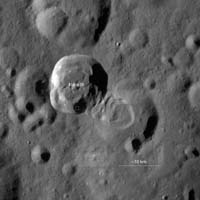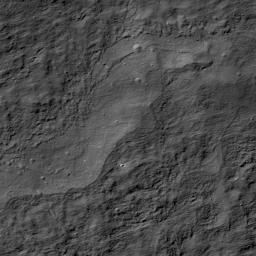Impact Melt on Klute W Wall
Caption:
Impact melt deposits on interior wall of Klute W crater. Image is 900 meters wide, LROC NAC M143201144RE.
Further down the wall of Klute W crater (38.2°N, 143.0°W) relative to yesterday's featured image, the landslide rubble appears to have either been mixed with, or deposited adjacent to, impact melt. The melt deposits produce lobate margins appearing much like lava flows, and the smoother surfaces present more small impact craters than the nearby rough surfaces. Unlike the unconsolidated (loosely packed) landslide debris, the melt surfaces should be solid rock, having formed from rapidly cooling melt following the Klute W impact. Melt surfaces are therefore expected to preserve craters better than landslide materials (see
PIA14029
).

|
|
Click on image for larger version
|
|
|
LROC WAC monochrome mosaic of Klute W and its surroundings
|
|
Background Info:
NASA's Goddard Space Flight Center built and manages the mission for the Exploration Systems Mission Directorate at NASA Headquarters in Washington. The Lunar Reconnaissance Orbiter Camera was designed to acquire data for landing site certification and to conduct polar illumination studies and global mapping. Operated by Arizona State University, LROC consists of a pair of narrow-angle cameras (NAC) and a single wide-angle camera (WAC). The mission is expected to return over 70 terabytes of image data.
Cataloging Keywords:
| Name |
Value |
Additional Values |
| Target |
Moon |
|
| System |
Earth |
|
| Target Type |
Satellite |
|
| Mission |
Lunar Reconnaissance Orbiter (LRO) |
|
| Instrument Host |
Lunar Reconnaissance Orbiter |
|
| Host Type |
Orbiter |
|
| Instrument |
Lunar Reconnaissance Orbiter Camera (NAC) |
|
| Detector |
|
Narrow Angle Camera (NAC), Wide Angle Camera (WAC) |
| Extra Keywords |
Crater, Grayscale, Impact |
| Acquisition Date |
|
| Release Date |
2011-04-01 |
| Date in Caption |
|
|
| Image Credit |
NASA/GSFC/Arizona State University |
| Source |
photojournal.jpl.nasa.gov/catalog/PIA14030 |
| Identifier |
PIA14030 |


